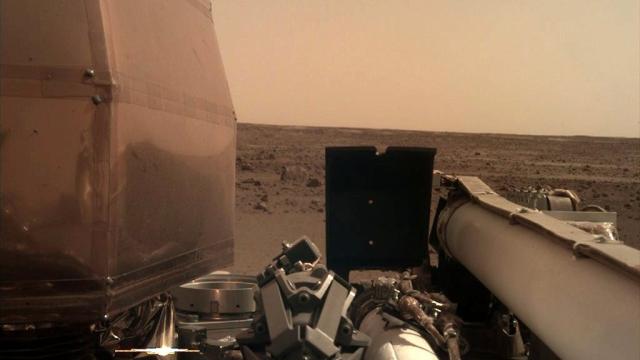NASA’s InSight (Interior Exploration using Seismic Investigations, Geodesy and Heat Transport) probe successfully completed its soft landing on Mars on Monday after a six-month, 300 million mile journey. And it’s already sending back photos of the desolate Red Planet from its landing site on the Elysium Planitia, courtesy of a post on the lander’s official Twitter feed reading, “There’s a quiet beauty here. Looking forward to exploring my new home.”
There’s a quiet beauty here. Looking forward to exploring my new home. #MarsLanding pic.twitter.com/mfClzsfJJr
— NASAInSight (@NASAInSight) November 27, 2018
InSight has already deployed its two decagonal solar arrays, which span seven feet each and provide the craft’s operational power supply. Its mission is to provide insights into how rocky planets like Mars form and evolve over time, and it’s equipped with instruments including a seismometer, a burrowing heat probe, and radio science gear.
Per a NASA statement, InSight will begin collecting some data within its first week of operations, though its Earth-based staff are primarily working on activating and calibrating its systems. One of the first tasks on its list is deploying a 1.80m robotic arm that will take photos of the Martian landscape, which will be completed in a few days. Many of its experiments will take time to develop, as NASA will require extensive data to decide where to deploy the seismometer and burrowing heat probe, and may have to wait further still for any seismic activity to be detected.
NASA wrote:
“We hit the Martian atmosphere at 19,800 kilometers per hour, and the whole sequence to touching down on the surface took only six-and-a-half minutes,” said InSight project manager Tom Hoffman at JPL. “During that short span of time, InSight had to autonomously perform dozens of operations and do them flawlessly — and by all indications that is exactly what our spacecraft did.”
… “Landing was thrilling, but I’m looking forward to the drilling,” said InSight principal investigator Bruce Banerdt of [NASA’s Jet Propulsion Laboratory]. “When the first images come down, our engineering and science teams will hit the ground running, beginning to plan where to deploy our science instruments. Within two or three months, the arm will deploy the mission’s main science instruments, the Seismic Experiment for Interior Structure (SEIS) and Heat Flow and Physical Properties Package (HP3) instruments.”
This is actually not the first surface photo transmitted by InSight that has been released by NASA. Another released earlier on Monday was a blurry photo of the lander’s dust-speckled lens cover, beyond which the Martian horizon can be seen.
My first picture on #Mars! My lens cover isn’t off yet, but I just had to show you a first look at my new home. More status updates:https://t.co/tYcLE3tkkS #MarsLanding pic.twitter.com/G15bJjMYxa
— NASAInSight (@NASAInSight) November 26, 2018
InSight also deployed two tiny cubesats named MarCO A and B before landing, which CNN reported are the first to be deployed to deep space. Neither craft was integral to the mission itself, according to the Los Angeles Times, but they did work flawlessly. MarCO B also transmitted an additional photo of Mars from orbit. The entirety of the two cubesats’ data will take two weeks to reach Earth. As their mission is complete, they will now enter an elliptical orbit around the Sun, though they are expected to continue operating for a few weeks.
We’ll always have #Mars.
After relaying live communications for @NASAInSight as it landed, the tiny #MARCO B cubesat sent back this farewell image of the planet. #MarsLanding pic.twitter.com/EQzrLX8fsv
— NASA JPL (@NASAJPL) November 26, 2018
While those of us on Earth may have to wait some time to hear what InSight learns about its new home, it’s had a stunning introduction.
Per NASA, other institutions that have contributed to its mission are listed below:
A number of European partners, including France’s Centre National d’Études Spatiales (CNES) and the German Aerospace Center (DLR), are supporting the InSight mission. CNES, and the Institut de Physique du Globe de Paris (IPGP), provided the SEIS instrument, with significant contributions from the Max Planck Institute for Solar System Research (MPS) in Germany, the Swiss Institute of Technology (ETH) in Switzerland, Imperial College and Oxford University in the United Kingdom, and JPL. DLR provided the HP3 instrument, with significant contributions from the Space Research Center (CBK) of the Polish Academy of Sciences and Astronika in Poland. Spain’s Centro de Astrobiología (CAB) supplied the wind sensors.
